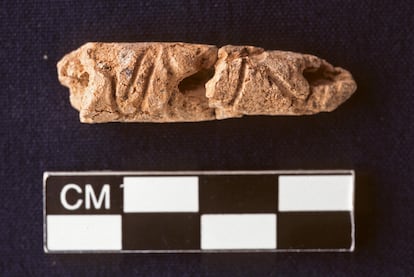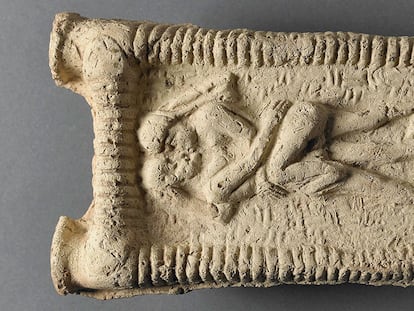The first alphabet may be 500 years older than previously thought
Egyptian hieroglyphics were used 3,250 years before our era, but there is an even older precursor: the cuneiform writing of Mesopotamia

There are hundreds of alphabets and writing systems in the world. The brilliant invention of a symbolic code to record human history, however, ironically did not preserve the details of its own origin. We still cannot pinpoint with certainty when or where the alphabet was first created. Until now, it was widely believed to have emerged around 1900 BCE in what is now Egypt. A recent discovery in Syria, however, suggests that the alphabet’s origin may date back an additional 500 years.
Egyptian hieroglyphics were in use as early as 3250 BCE, but an even older precursor existed in the cuneiform script of Mesopotamia. Neither hieroglyphics nor cuneiform were alphabets in the modern sense, relying instead on symbols and syllables. The first alphabet is thought to be the Proto-Sinaitic script, discovered in 1904 in the Sinai Peninsula by Egyptologist William Matthew Flinders Petrie.
Around 1900 B.C., the time when this script was in use — of which only a few dozen examples survive — the inhabitants of the Sinai were Semites under Egyptian rule. It is believed that they adapted the Egyptian hieroglyphs to their own language, inventing a consonantal alphabet, which would later lead to the Phoenician and Greek alphabets. But was this truly the first?
In 2004, an excavation at Tell Umm-el Marra, an ancient city about 35 miles east of Aleppo, Syria, unearthed a tomb containing six skeletons, jewelry, cooking utensils, a spearhead, ceramic vessels, and four perforated clay cylinders inscribed with symbols. In 2010, Glenn Schwartz, co-director of the excavation and a professor at Johns Hopkins University, suggested in a paper that these marks might represent a form of writing. “I was cautious not to push the similarity to alphabetic characters too far, because I’m an archaeologist, not a philologist or an expert on ancient writing systems,” Schwartz explains.
A unique invention
The response to his study among philologists was nonexistent; no one commented or engaged with his hypothesis. However, convinced that the marks on the cylinders were comparable to the ancient alphabets of the region, Schwartz presented his proposal again in 2019 at a conference and in 2021 in a new study. This time, two experts on ancient alphabets, Christopher Rollston and Madadh Richey, agreed with him. “With two experts now in agreement, I decided it was time to share it more widely,” says Schwartz. He has now presented all the details of his discovery at the annual meeting of the American Society of Overseas Research
“These four inscriptions display the hallmarks of alphabetic writing, based on the morphology and the shape of several of the signs,” says Rollston, a professor of Biblical and Near Eastern languages and civilizations at George Washington University, who had worked with Schwartz in the past but was not involved in the discovery. “It seems reasonable to me to consider them alphabetic writing.” Rollston says that he studied Schwartz’s discovery for years before issuing his verdict, which he posted on his blog in 2021.
If the marks on the cylinders indeed represent a form of writing, they would also rewrite the history of the alphabet. Carbon-14 dating places their origin around 2,400 BC, which suggests that the Tell Umm-el Marra alphabet predates the Proto-Sinaitic alphabet by half a millennium. According to Rollston, “the alphabet was invented once, and all alphabetic writing systems derive from the original alphabet,” meaning that this would be the first alphabet from which others, including the Proto-Sinaitic, originated. Rollston’s only doubt concerns the reliability of the dating and whether the cylinders could be from a later period, but Schwartz stands by his findings.
The mystery of “Silanu”
Not all experts are convinced. Philippa Steele, a researcher in classical culture at Cambridge University, notes that while she is not a complete skeptic and believes it is a writing system, she questions whether it can be classified as alphabetic. “The main problem is that there are too few signs to definitively prove that it is an alphabetic system,” she explains. Steele argues that an alphabet typically consists of 20 to 40 signs, whereas a syllabic script contains more than 50, and in this case, it’s unclear which category it falls into. “Some of the signs resemble other alphabetic signs from Proto-Sinaitic, but there’s no obvious relationship in others.” Steele would like to see additional examples from a larger sample, but such evidence has yet to be found.
Schwartz not only defends the alphabetic nature of the inscriptions but also offers a possible reading of one of them: “Silanu.” “My colleague Ted Lewis, a professor at my university and an expert on ancient Semitic languages, suggested this interpretation, which I think is worth considering,” he says. As for the meaning of the word, one can only speculate. Schwartz suggests that it could be a name, with the hollow cylinders perhaps serving as labels tied to vessels, and “Silanu” potentially referring to the giver or recipient of a gift. However, Steele cautions that “it is difficult to make such a suggestion beyond mere speculation.”
Steele’s objections also stem from the lack of context, as well as geographical and chronological consistency. She questions whether an entire alphabet, which would have required time and effort to develop and was believed to have been widespread, could have remained hidden, with such few surviving samples. But Schwartz explains why this may be the case: “The clay cylinders are small, fragile, and blend in with the color of the soil. At first glance, they look like pieces of dirt, so it would be easy to overlook them. Moreover, it’s possible that the people of that time wrote on more perishable materials.” He concludes: “If the excavations in Syria continue, perhaps more examples will surface.”
Sign up for our weekly newsletter to get more English-language news coverage from EL PAÍS USA Edition
Tu suscripción se está usando en otro dispositivo
¿Quieres añadir otro usuario a tu suscripción?
Si continúas leyendo en este dispositivo, no se podrá leer en el otro.
FlechaTu suscripción se está usando en otro dispositivo y solo puedes acceder a EL PAÍS desde un dispositivo a la vez.
Si quieres compartir tu cuenta, cambia tu suscripción a la modalidad Premium, así podrás añadir otro usuario. Cada uno accederá con su propia cuenta de email, lo que os permitirá personalizar vuestra experiencia en EL PAÍS.
¿Tienes una suscripción de empresa? Accede aquí para contratar más cuentas.
En el caso de no saber quién está usando tu cuenta, te recomendamos cambiar tu contraseña aquí.
Si decides continuar compartiendo tu cuenta, este mensaje se mostrará en tu dispositivo y en el de la otra persona que está usando tu cuenta de forma indefinida, afectando a tu experiencia de lectura. Puedes consultar aquí los términos y condiciones de la suscripción digital.
More information
Archived In
Últimas noticias
Reinhard Genzel, Nobel laureate in physics: ‘One-minute videos will never give you the truth’
Pinochet’s victims grapple with José Antonio Kast’s rise in Chile
From digital curfews to blocking apps: How technology experts protect their children online
Why the price of coffee has skyrocketed: from Brazilian plantations to specialty coffee houses
Most viewed
- Pablo Escobar’s hippos: A serious environmental problem, 40 years on
- Why we lost the habit of sleeping in two segments and how that changed our sense of time
- Trump’s obsession with putting his name on everything is unprecedented in the United States
- Charles Dubouloz, mountaineering star, retires at 36 with a farewell tour inspired by Walter Bonatti
- The Florida Keys tourist paradise is besieged by immigration agents: ‘We’ve never seen anything like this’










































